|
|
|
Sort Order |
|
|
|
Items / Page
|
|
|
|
|
|
|
| Srl | Item |
| 1 |
ID:
168996
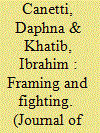

|
|
|
|
|
| Summary/Abstract |
How does the subjective conceptual framing of conflict impact the warring parties’ attitudes towards political compromise and negotiation? To assess strategies for conflict resolution, researchers frequently try to determine the defining dispute of a given conflict. However, involved parties often view the conflict through fundamentally distinct lenses. Currently, researchers do not possess a clear theoretical or methodological way to conceptualize the complexity of such competing frames and their effects on conflict resolution. This article addresses this gap. Using the Israeli–Palestinian conflict as a case study, we run a series of focus groups and three surveys among Jewish citizens of Israel, Palestinian citizens of Israel (PCIs), and Palestinians in the West Bank. Results reveal that three conflict frames are prominent – material, nationalist, and religious. However, the parties to the conflict differ in their dominant interpretation of the conflict. Jewish Israelis mostly frame the conflict as nationalist, whereas Palestinians, in both the West Bank and Israel, frame it as religious. Moreover, these frames impact conflict attitudes: a religious frame was associated with significantly less willingness to compromise in potential diplomatic negotiations among both Jewish and Palestinian citizens of Israel. Interestingly, differing frames had no significant impact on the political attitudes of West Bank Palestinians, suggesting that the daily realities of conflict there may be creating more static, militant attitudes among that population. These results challenge the efficacy of material solutions to the conflict and demonstrate the micro-foundations underpinning civilians’ conflict attitudes and their implications for successful conflict resolution.
|
|
|
|
|
|
|
|
|
|
|
|
|
|
|
|
| 2 |
ID:
169001


|
|
|
|
|
| Summary/Abstract |
The literature on civil wars has recently turned towards their international context but lacks an account for how conflict beyond a state’s borders contributes to civil war onset. I argue that interstate rivalries can increase the risk of civil war in other states when rivals come to associate the foreign-policy orientation of other states with their own security. I present three pathways through which rivals increase the risk of civil war in other states. First, competition between rivals creates a ratchet effect by which the prospect of one’s involvement in a conflict makes it more likely that the other becomes involved. This dynamic makes support easier to secure and lowers the expected costs of war for governments and opposition groups. Second, rivals encourage domestic polarization as parties attempt to capture their influence, making domestic conflicts more intractable. Third, uncertainty over the potential for intervention by rivals increases the risk of miscalculation. I test the implications of the theory with novel spatial measures of interstate conflict and rivalry. Using logistic regressions and random forests, I find that being in the neighborhood of interstate rivals can increase a state’s risk of civil war.
|
|
|
|
|
|
|
|
|
|
|
|
|
|
|
|
| 3 |
ID:
169004
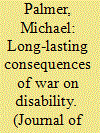

|
|
|
|
|
| Summary/Abstract |
This article investigates the impact of exposure to United States air force bombing during 1965–75 on the disability status of individuals in Vietnam in 2009. Using a combination of national census and US military data and an instrumental variable strategy which exploits the distance to the former North–South border as a quasi-experiment, the article finds a positive and significant impact of bombing exposure on district level disability rates 40 years after the war. The overall effect of bombing on the long-term disability rate among the Vietnamese population is highest among heavily bombed districts. Districts in the top bombing quintile experience a 25% relative increase in the rate of disability attributable to bombing compared with districts in the lowest bombing quintile. Effects are highest on the prevalence of severe disability and among cohorts before the war’s end. A smaller, yet significant, effect is found among cohorts born after the war. The article finds further evidence of indirect channels through which bombing may have impacted on long-term disability including adverse effects on nutritional environment and human capital attainment. These findings add to the evidence from Vietnam and indicate that wars inflict costs on the health of human populations that last longer than those relating to economic growth and welfare.
|
|
|
|
|
|
|
|
|
|
|
|
|
|
|
|
| 4 |
ID:
169003
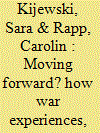

|
|
|
|
|
| Summary/Abstract |
How does civil war shape the prospects of lasting peace between formerly opposing ethnic groups after the end of violence? This article addresses the complex relationship between war experience, interethnic attitudes, interethnic forgiveness, and the willingness to permit basic civil liberties to former enemies in the context of postwar Sri Lanka. Despite the end of the 26-year-long civil war in 2009, social and political tensions between the two largest ethnic groups, the Sinhalese and the Sri Lankan Tamils, still prevail. Political tolerance is in the literature considered a crucial micro-level condition for peaceful coexistence, yet, its determinants, in particular the role of war experiences, have not received sufficient attention. Using new and unique all-island representative survey data (N = 1,420), we examine the mutual permission of civil liberties of these two ethnic groups. Our analyses reveal two important findings: first, the likelihood of granting civil liberties varies by civil liberty and ethnic group. Whereas most members of both ethnic groups are willing to grant the right to vote, to hold a speech, and to hold a government position, the right to demonstrate is highly contested, with only low shares of both Tamils and Sinhalese being willing to grant the other group this right. Second, the structural equation models reveal that the direct impact of war exposure is less powerful than expected and depends on the political right in question. Not forgiving the other ethnic group, partly driven by war experience and ethnic prejudice, appears to be a more consistent predictor of intolerance. These results imply that postwar efforts to further forgiveness are important to promote political tolerance and thereby long-lasting peace.
|
|
|
|
|
|
|
|
|
|
|
|
|
|
|
|
| 5 |
ID:
169002
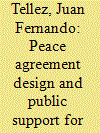

|
|
|
|
|
| Summary/Abstract |
Conflict negotiations are often met with backlash in the public sphere. A substantial literature has explored why civilians support or oppose peace agreements in general. Yet, the terms underlying peace agreements are often absent in this literature, even though (a) settlement negotiators must craft agreement provisions covering a host of issues that are complex, multidimensional, and vary across conflicts, and (b) civilian support is likely to vary depending on what peace agreements look like. As a result, we know much less about how settlement design molds overall public response, which settlement provisions are more or less controversial, or what citizens prioritize in conflict termination. In this article, I identify four key types of peace agreement provisions and derive expectations for how they might shape civilian attitudes toward conflict termination. Using novel conjoint experiments fielded during the Colombian peace process, I find evidence that citizens evaluate agreements based primarily on how provisions mete out justice to out-group combatants, and further that transitional justice provisions produced sharp divisions among urban voters in the 2016 referendum. Additional analysis suggests that material, distributive concerns were particularly salient for rural citizens. The results have implications for understanding the challenge of generating public buy-in for conflict termination and sheds light on the polarizing Colombian peace process.
|
|
|
|
|
|
|
|
|
|
|
|
|
|
|
|
| 6 |
ID:
168998
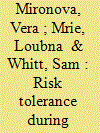

|
|
|
|
|
| Summary/Abstract |
When war breaks out, how important are risk preferences to explaining why some individuals stay in conflict zones while others take flight? We examine risk tolerance among rebel combatants and civilians in Aleppo, Syria using a variation of the Eckel-Grossman Choice Game. Field work in Syria was conducted in 2013–14 with a total of 232 participants to include both Syrian civilians and active rebel fighters in Aleppo and Idlib Province, as well as among Syrian refugees in neighboring Turkey. Compared to Syrians in other locations, people in rebel-held territory of Aleppo, both combatants and non-combatants, are significantly more risk tolerant. We consider possible explanations for elevated risk preferences in Aleppo based on self-selection, adaptive learning, a sense of self-efficacy to affect future outcomes, conflict-related grievances, and in-group solidarity. Our analysis suggests that self-selection based on access to resources and a strong sense of self-efficacy may explain higher propensity for risk-taking. Overall, our results speak to a plausible sorting mechanism during conflict where risk averse individuals select out of conflict, while highly risk tolerant individuals are more prone to discount the inherent dangers of remaining in conflict zones. Our results provide new micro-level explanation for why some societies become mired in conflict traps involving highly risk tolerant fighting communities.
|
|
|
|
|
|
|
|
|
|
|
|
|
|
|
|
| 7 |
ID:
168999
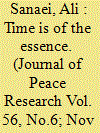

|
|
|
|
|
| Summary/Abstract |
It is often observed that public support for asymmetric wars diminishes over time, but the micro foundations of this observation are not fully understood. I present a modified war of attrition model for asymmetric wars which shows that as time passes, belligerents’ expectations for the remaining duration of war increase and they find fighting less favorable. Even when we keep the average rate of casualty accrual constant, the anticipated length of fighting into the future affects expected remaining costs of war. Therefore, in a cost-benefit calculation, observed duration causally affects expected remaining costs of war and, hence, leads to lower levels of support for war over time. The longer the war lasts, the more it will look like a never-ending war which may encourage the strong side to cut its losses short and stop the war. Because duration and aggregate costs are highly correlated in observational data, I use a randomized survey experiment to separate the effect of duration from the effect of costs on support for war. The result is that duration has a negative effect on public support which is independent of aggregate costs. This helps us better understand the limits of democratic states’ capabilities in fighting asymmetric wars and suggests that when military planners ignore the role of time, they deploy weaker-than-optimal forces.
|
|
|
|
|
|
|
|
|
|
|
|
|
|
|
|
| 8 |
ID:
168997


|
|
|
|
|
| Summary/Abstract |
Does public opinion act as a constraint on military action, are ordinary citizens the easily manipulated targets of the public relations efforts of their governments, or does the general public react as assertively to threats as decisionmakers? This article examines the causal connection between military action, public opinion and threats. Empirically, it focuses on the pattern of EU member state participation in two recent military operations: the 2011 intervention in Libya and the operation against the self-proclaimed Islamic State (IS). Three competing causal models on the relationship between threats, public opinion and military action were derived from the scholarly literature and tested with coincidence analysis. The results of the analysis show that public opinion acted as a constraint on executives during the Libya operation. However, there was no direct causal link between public opinion and military participation in the operation against IS, in which both military action and public support were an effect of threat. More generally, the results suggest that the context of the intervention is decisive for the relation between threat, military action and public support. More specifically, whether public opinion constitutes a constraint on military action or is an effect of threats to national interests depends on whether these threats are clear and tangible.
|
|
|
|
|
|
|
|
|
|
|
|
|
|
|
|
| 9 |
ID:
169000
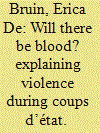

|
|
|
|
|
| Summary/Abstract |
Although just under half of all coup d’état attempts involve fatalities, there has been surprisingly little attention to the conditions under which coups turn violent. Existing research emphasizes the incentives coup plotters have to avoid bloodshed but does not explain the conditions under which violence nonetheless occurs. This article develops a theoretical framework that predicts that the extent of violence that occurs during coup attempts will vary systematically with central features of incumbent regimes and coup plotters. It then tests these predictions using new data on the fatalities associated with 377 coup attempts between 1950 and 2017. Coups against military regimes are found to be less violent than those against civilian dictatorships. This is because military rulers are better able to estimate the likelihood of the coup succeeding and more sensitive to the costs associated with using violence to suppress a coup. Since their post-coup fates tend to be better than those of other authoritarian leaders, they also have fewer incentives to hang on to power at any cost. The analysis also demonstrates that coups led by senior officers involve less bloodshed than those by junior officers and enlisted men. However, coups against rulers that counterbalance their militaries are no more violent than those against rulers that do not. The results shed new light on the dynamics of coup attempts.
|
|
|
|
|
|
|
|
|
|
|
|
|
|
|
|
|
|
|
|
|